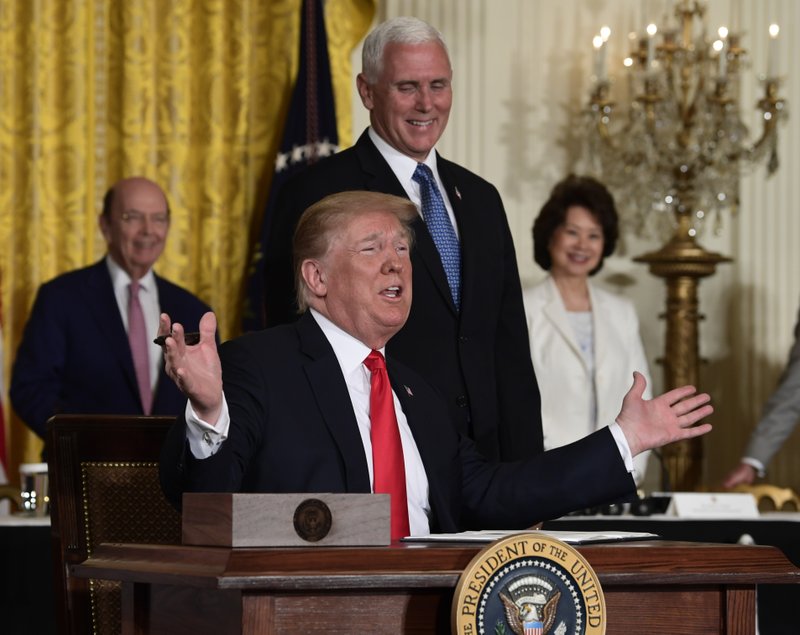WASHINGTON -- The United States and China edged closer Tuesday to triggering a trade war, with President Donald Trump signaling skepticism that talks with China would help end the disagreement.
"We have to do something about it. Now, maybe something happens where they come and they say, 'We agree, it's been unfair for the last 25 years,"' he said during remarks to the National Federation of Independent Business. "But somehow that doesn't seem to work so easily. But we're going, and we're going to make it fair."
If the tariffs the two countries have threatened to impose on imports take effect, their consumers would have to pay higher retail prices. Companies would pay more for imported parts and would have to decide whether to absorb those higher costs -- or pass them on to their customers.
American farmers could be shut out of a lucrative market for their goods. U.S. companies, such as Caterpillar and Qualcomm, would likely face obstruction from regulators in China, a market they rely on for an outsize share of sales.
World financial markets buckled Tuesday, a day after Trump ratcheted up the tensions by proposing a fresh batch of tariffs on Chinese products. With concerns growing on Wall Street, the Dow Jones industrial average dropped nearly 300 points -- more than 1 percent -- on its sixth-straight losing day. Stocks tumbled nearly 3 percent in Hong Kong, 2 percent in Tokyo and 4 percent in Shanghai.
Trump previously ordered 25 percent tariffs on $50 billion in Chinese goods in retaliation for Beijing's forced transfer of U.S. technology and for intellectual-property theft. Those tariffs, set to take effect July 6, were matched by China's threat to penalize U.S. exports.
[FULL LIST: Chinese products that will be subject to additional tariffs + more products under review]
Beijing's response drew the president's ire. On Monday night, Trump told his trade representative, Robert Lighthizer, to target an additional $200 billion in Chinese goods for 10 percent tariffs. These penalties will take effect, the White House said, "if China refuses to change its practices" and proceeds with its plans for retaliatory tariffs.
The standoff could escalate further yet: Trump threatened tariffs on another $200 billion in Chinese products if Beijing lashes back again. Combined, the potential tariffs on Beijing could cover $450 billion -- a sum equal to 89 percent of Chinese goods imported to the United States last year.
"He's upping the ante," Wendy Cutler, a former U.S. trade negotiator who is now at the Asia Society Policy Institute, said of Trump. "He's willing to totally close our market to their exports. There are going to be serious consequences."
The tariffs would start to slow U.S. growth, economists warn. Oxford Economics estimates that if Trump imposed the $200 billion in tariffs and China responded in kind, U.S. growth could slow by 0.3 percentage point next year.
Trump is gambling that Beijing has the most to lose. China couldn't come close to matching America's tariffs on $450 billion of Chinese exports. The United States sold only $130 billion of goods to China last year.
But Beijing has chosen its targets strategically. Soybeans are on the list -- a direct shot at a swath of Trump supporters in the American heartland. About 60 percent of U.S. soybean exports go to China.
And Beijing has other ways to inflict pain on American companies. It could delay or deny licenses that American companies need to operate in China. Or it could hold up their products at customs.
U.S. companies have an increasingly sizable stake in the fast-growing Chinese market. They've invested a cumulative $256 billion there since 1990 (versus the $140 billion China has invested in the United States), according to the Rhodium Group research firm and the National Committee on United States-China Relations.
Companies in the Standard & Poor's 500 index derive a collective 5.5 percent of their revenue from China, according to the data firm FactSet.
The Trump administration has tried to limit the effect of the tariffs on American consumers. Trump's original $50 billion tariff list was heavy on industrial equipment. And his trade adviser, Peter Navarro, said Tuesday that the Office of the U.S. Trade Representative and the Council of Economic Advisers were working to spare consumers.
But the more the target list expands, the more likely consumers will be hurt -- one reason the administration lowered the tariffs on the next $200 billion in imports to 10 percent from the 25 percent on the original $50 billion.
Analysts say Beijing is determined to develop its technological prowess and create world-leading companies in such fields as robotics and electric cars under a program it calls "China 2025." U.S. officials argue that this program unfairly discriminates against U.S. and other foreign companies operating in China.
"Trump's view that bullying and threats will advance U.S. long-term economic interests seems set to encounter a harsh dose of realism," said Eswar Prasad, professor of trade policy at Cornell University. "China is in no mood to negotiate against a background of escalating threats and hostile rhetoric."
Information for this article was contributed by Paul Wiseman, Zeke Miller, Jeff Karoub, Ken Thomas, Christopher Rugaber, Gillian Wong, Joe McDonald and Christopher Bodeen of The Associated Press; and by Jenny Leonard, Enda Curran and Saleha Mohsin of Bloomberg News.
Business on 06/20/2018
